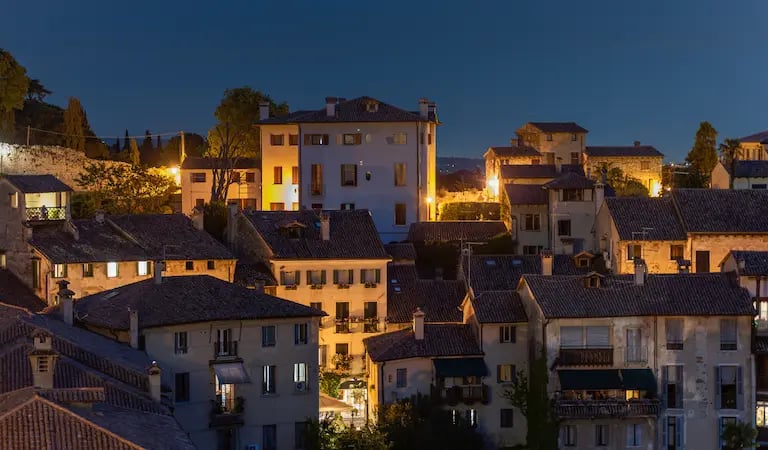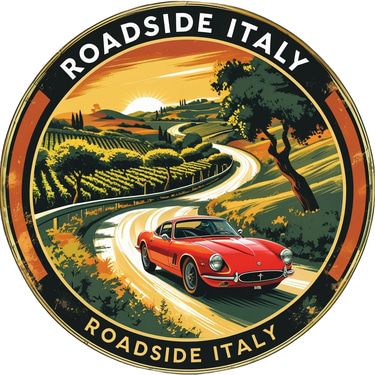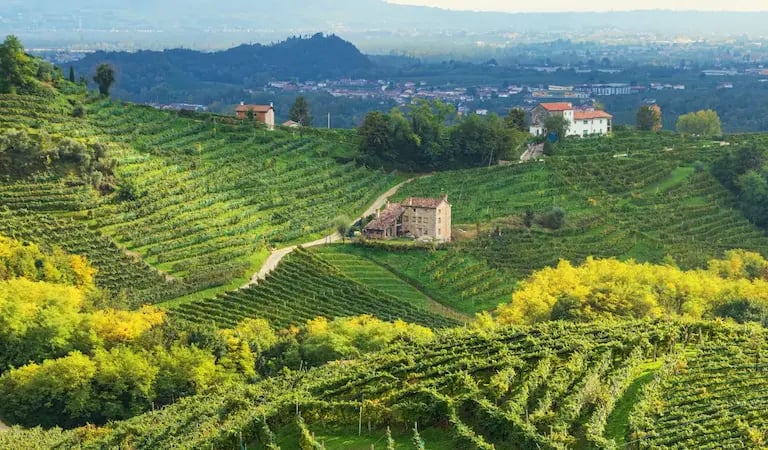Prosecco Wine: The Sparkling Soul of Veneto
Discover Prosecco wine: history, Prosecco Rosé, Champagne comparison, Asolo Prosecco, curiosities, and Veneto wine tours from Venice.
VENETOFOOD


Prosecco wine is not just Italy’s most beloved sparkling—it’s a symbol of everyday celebration. Produced in the rolling hills of Veneto, this sparkling gem is light, floral, and accessible, making it a global star on dinner tables and aperitivo bars alike. Recognized by UNESCO as a World Heritage landscape, the Prosecco Hills of Conegliano and Valdobbiadene are as much a travel destination as they are a wine region. From the rise of Prosecco Rosé wine to the elegance of Asolo Prosecco wine, from the eternal debate of Prosecco wine vs Champagne, to joining Veneto wine tours from Venice, this is your complete guide to Italy’s sparkling treasure.
History and Origins of Prosecco Wine
The story of Prosecco dates back over 2,000 years. Roman writers praised a wine called Pucinum, believed to be the ancestor of Prosecco. The grape behind Prosecco today is Glera, a variety cultivated for centuries in northeast Italy.
In the 19th century, Conegliano became home to Italy’s first wine school, which helped modernize viticulture and strengthen Prosecco’s reputation. Today, the Consorzio Tutela Prosecco DOC protects the name, ensuring only wines produced in specific regions can carry the Prosecco label.
In 2019, the Prosecco Hills of Conegliano and Valdobbiadene were added to the UNESCO World Heritage list, highlighting not only the cultural value of these vineyards but also the centuries-old harmony between people and landscape: https://whc.unesco.org/en/list/1571
Ingredients and Preparation
Main grape: Glera (minimum 85%), blended occasionally with Verdiso, Perera, or Chardonnay.
Production method: Prosecco is made using the Charmat method, where the second fermentation occurs in stainless steel tanks. This preserves fruity aromas and makes Prosecco fresher and more approachable than Champagne.
Taste profile: crisp apple, pear, peach, acacia blossoms, and lively bubbles.
Prosecco Rosé Wine – A Modern Twist
Since 2020, wine lovers have been able to enjoy Prosecco Rosé wine, an official category in the DOC.
Produced by blending Glera grapes with 10–15% Pinot Noir.
Characterized by pale pink hues, aromas of wild berries and rose petals.
Perfect for summer aperitivo, weddings, or casual brunches.
As Decanter notes, Prosecco Rosé has boosted demand globally, attracting younger audiences and adding a stylish edge to Veneto’s sparkling tradition: https://www.decanter.com
Prosecco Wine vs Champagne – The Key Differences
Though both sparkle in the glass, Prosecco wine vs Champagne is a fascinating comparison:
Fermentation: Champagne uses Méthode Traditionnelle (in-bottle fermentation), while Prosecco uses Charmat (tank fermentation).
Flavor: Champagne develops toasty, nutty complexity; Prosecco is fruity, floral, and refreshing.
Aging: Champagne ages for years on the lees; Prosecco is bottled young for freshness.
Price: Prosecco is typically more affordable.
Occasions: Champagne suits luxury dining and ceremonies; Prosecco shines at everyday gatherings, aperitivo, and festive toasts.
The Comité Champagne emphasizes that the two represent distinct traditions—both excellent in their own right.
Asolo Prosecco Wine – Veneto’s Hidden Jewel
Among the DOCG zones, Asolo Prosecco wine is a rising star. Produced around the medieval town of Asolo, this DOCG is known for finesse and minerality.
The official Asolo Prosecco Superiore DOCG describes its wines as elegant and structured, often considered more artisanal compared to the larger Valdobbiadene production. If you’re seeking a boutique tasting experience, Asolo is the place.
Where to Taste Prosecco Wine
Conegliano & Valdobbiadene
The UNESCO-recognized hills are dotted with wineries, from family-run cellars to modern estates. Conegliano houses the historic wine school; Valdobbiadene offers breathtaking vineyard landscapes.
Asolo
A more intimate DOCG zone, where tastings often mean sitting down with the winemaker: https://www.asoloprosecco.it
Veneto Wine Tours from Venice
The easiest way for visitors is joining guided Veneto wine tours from Venice.
These tours usually include transfers from Venice, tastings at 2–3 wineries, and traditional Venetian or Veneto-style lunch.
Ideal for travelers who want a full-day escape without worrying about driving
Book your Prosecco day trip from Venice — includes 2 tastings: https://gyg.me/T6EbdwnI
Not Everyone Knows That…
The Perfect Glass for Prosecco
Not everyone knows that the best glass for tasting Prosecco is not the flute, but the tulip-shaped glass.
The narrower opening directs the wine to the tip of the tongue, enhancing freshness.
The rounded bowl allows aromas to concentrate and oxygenate properly.
Fill the glass only to its widest point, so bubbles rise gently without excess foam.
The Ideal Serving Temperature
Not everyone knows that Prosecco should not be served ice-cold.
Freezing it mutes the delicate aromas.
The ideal serving temperature is 6–8°C (43–46°F).
This range preserves floral scents and makes the bubbles more elegant.
Prosecco Millesimato
Not everyone knows that “Millesimato” comes from the French millesimé, meaning “vintage.”
A Millesimato Prosecco is made with at least 85% grapes from a single harvest year.
It represents elegance and refinement, often chosen for celebrations.
Excellent with seafood, antipasti, or salty appetizers.
Conclusion
A glass of Prosecco wine is more than bubbles—it’s a cultural journey through Veneto’s hills. From the playful charm of Prosecco Rosé wine to the sophistication of Asolo Prosecco wine, from the lively debate of Prosecco wine vs Champagne to the chance to explore the UNESCO hills on Veneto wine tours from Venice, Prosecco is Italy’s way of toasting life.
Whether you’re enjoying it at a Venetian bacaro, on a vineyard terrace in Valdobbiadene, or at home with friends, Prosecco proves that joy can sparkle in every glass.
FAQ
Q1. What grape is used to make Prosecco?
The main grape is Glera (at least 85%), sometimes blended with Verdiso, Perera, or Chardonnay for added character.
Q2. What is the difference between Prosecco and Champagne?
The key lies in production methods. Champagne ferments in the bottle (Méthode Traditionnelle), giving nutty, toasty complexity. Prosecco ferments in tanks (Charmat method), preserving fresh fruit and floral aromas.
Q3. What does “Millesimato” Prosecco mean?
It refers to a vintage Prosecco, made with at least 85% grapes from a single harvest year. It’s generally more refined and often chosen for special occasions.
Q4. How should Prosecco be served?
Best enjoyed at 6–8°C (43–46°F) in a tulip-shaped glass. This enhances its freshness and allows delicate aromas to open up.
Q5. Where can you taste Prosecco in Italy?
The Conegliano and Valdobbiadene hills (UNESCO site) and the Asolo DOCG area are the most authentic places. Many guided tours depart from Venice and include tastings in historic wineries.




